Good evening CAPCOM,
The following is is the journalist report for Sol 3.
Best regards,
Cristian Acosta, HSO
Trouble Navigating on Mars
Today the crew woke up to a delightful breakfast made by our commander Yael, crew geologist Maria Paula, and crew scientist Felipe. It was egg and cheese with hydrated fruit and almonds on the side. The crews` spirits were lifted not only by the wonderful meal but also by the very engaging and hilarious morning conversations. Very entertaining these conversations were, that they even made us a bit late for our scheduled EVA at 9am. As a result, everyone seemed to be in a rush to save as much time as possible for the EVA that the chit chat ended abruptly. As Felipe and Cristian were in their crew quarters putting on their attire, Yael and Maria Paula went to the green hab to water the crops. Crew Engineer Carlos stayed on the upper deck to wash the dishes. Once all 3 EVA crew members were in the suiting room on the lower deck, it seemed like an eternity to get into the airlock as we were eager to get on our way as quickly as possible as we were already eating up 20 minutes of our EVA time in the suiting room. It did not help that multiple issues arised during the suiting up of the astronauts. For one, Cristian´s earpiece mic, was not working properly in the airlock and secondly no one on the EVA team had prepared to bring with them a time keeping device. Because of this, the EVA team had to depressurize twice in the airlock. Not a great start to the day. After pressurization, the EVA team, who comprised of Felipe, Cristian, and led by Maria Paula went to their respective rovers along with an additional companion. This companion was very small and surprisingly resistant to the harsh Martian surface environment. The crew was definitely not expecting this cute ratatouille (that had been baited with Nutella and captured the previous night) to survive in its unpressurized cage on Mars. The crew did not think much of it and continued on with the EVA. Both Cristian and Maria Paula got in and took off with rover Spirit, while Felipe took rover Percy. As the rovers made their way to the exploration site of "Moon Overlook" the cold martian air started to feel even colder with the relative wind. The team eventually reached a point on the main road that appeared to be the location to turn off of the main road leading to the exploration site. It also became a stopping point as Percy had reached a battery level of 63% and hence the crew no longer felt comfortable proceeding down the main road from that point. As the team left the vehicles to identify exactly the road upon which to further traverse the surface to the exploration site, it became clear that there were no obvious roads anywhere to be found. It was also at this point that the team unloaded the additional companion of the drive and set it free from its cage never to be seen again. Once freeing the little guy, the team set out to scout the area by walking West. As the team continued walking, they eventually stumbled upon a downward sloped feature that was a part of a network of small canyons. The crew seemed lost. They were not expecting this at all. Pictures were taken at this site not with wonder but with questions about the exact location of where they were. No help could come from the Hab as they were way beyond the range of the 2 way radios and as such, they were left to figure it out on there own. Fortunately, the crew had at there disposal a GPS which created even more confusion as they were reading on the map that they had arrived at the correct coordinates for the branch road that would lead them to the exploration site. The crew then started to observe the great amount of erosion that had occured on the land they were standing on. This led to thoughts about the road possibly having been erased. It was not all a lost cause as the crew did retrieve pieces of gypsum laying out on top of the surface. The radiated heat of the sun and the cold temperatures were definitely taking a toll on the crew and without much success in finding the road to the exploration site, the hope in doing so was rapidly diminishing. It was also getting late and after spending lots of time trying to find the road, the team decided on heading back. This time Cristian got in Percy while Maria Paula and Felipe got in Spirit. On their way back, the EVA team kept tabs on their respective battery levels by relaying that information over the 2 way radios between both rovers. The team also started to address the HAB in their radio callouts to determine when they were back within range. At last, comms between the rovers and the HAB were restored. What a relief it was to arrive back at the HAB with Percy at 50% and Spirit at 67%. Cristian thinking he had driven Spirit back, parked Percy in Spirit’s spot which left Spirit parking in Percy’s spot. To their great realization, the EVA team entered the airlock surprised on how quickly they had returned from the site compared to how long it took them to drive out to the site. Of course it could also be a matter of perception on time. After pressurization was completed in the airlock, the EVA team proceeded to takeoff their spacesuits and perform a debrief in the upper deck at he dinner table while having lunch. One thing to note is that while the expedition crew members were on their EVA, the mission commander Yael and crew engineer Carlos, were busy with performing chores in the HAB such as cleaning the lower deck. All in all, there were many lessons learned from performing this EVA and the crew all agreed on making changes to the daily schedule routine and be more prepared next time in order to reduce the risk of EVA mishaps. Lunch was Colombian-style beans with ground beef and rice with veggies. Without a doubt a very pleasing lunch. The crew’s cuisine is hands down one of the best and always is a boost to morale. Later in the afternoon, different crew members took naps and even started writing their respective reports. As the afternoon progressed and evening came, the crew got to work on both making a pizza and finishing up the required reports.


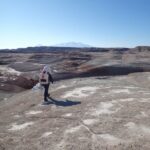
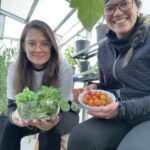
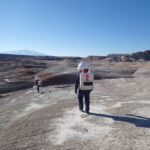
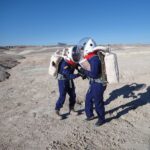
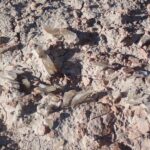
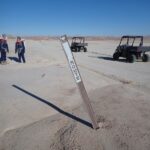
You must be logged in to post a comment.